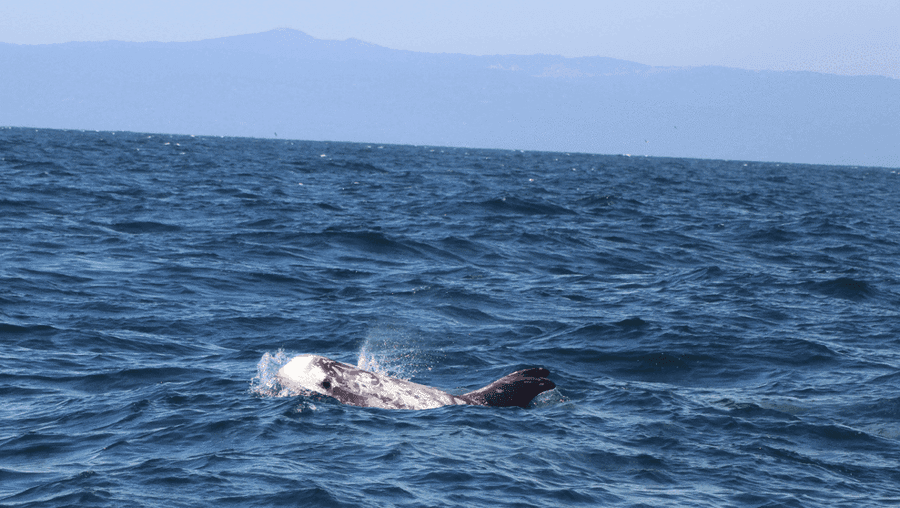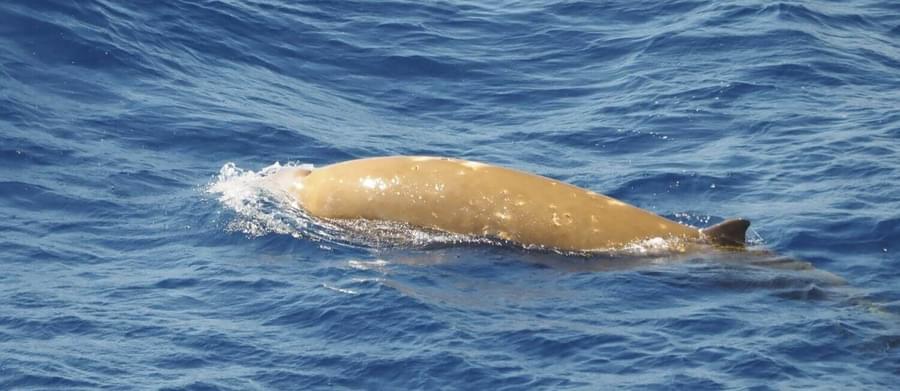Data Analyst Ellie K talks about cephalopods and cetaceans that eat them.
Sometimes, actually most of the time, I think it’s interesting to take a step back from cetaceans on their own and think about the ecosystem context in which cetaceans exist. It’s particularly interesting to think about how the so-called evolutionary arms race between predator and prey has shaped cetacean ecology and vice versa.
Cephalopods, or octopus, squid and cuttlefish (and nautilus) as you may know them, are really clever molluscs (1). They can change colour at will, solve puzzles and maybe even dream (1, 2). They are also a key component of marine ecosystems, whether as predators themselves or as prey for other predators and unsurprisingly, they are thought to be key in the transport of energy in marine food webs (3). Cephalopods are the primary food source of many cetacean species, most famously sperm whales - you may have seen artist’s impressions of epic battles between sperm whales and giant squid in the depths of the ocean - but also other species like Risso’s dolphins and most species of beaked whale (4, 5). Animals that eat a lot of cephalopods are known as teuthivores or sometimes teuthophages - teuthis comes from the Ancient Greek for squid while vore and phage refer to eating.
Cetaceans that have specialised in feeding on them have developed a few interesting adaptations. The most striking ones to the casual cetacean observer are reduced dentition and (very cute) blunt faces with wide mouths which somewhat counterintuitively result in a more circular mouth opening that maximises suction (6). This is because cephalopods are very slippery so trying to catch them and grab them with your teeth is not a very effective strategy to feed on them. Take (in my opinion) one of the cutest dolphins, the Risso’s dolphin as an example. They have the least teeth of any dolphin as in less than 20 compared to up to 100 in a bottlenose dolphin and a key identifying feature is their blunt face - one analysis indicates they have the bluntest head of any dolphin (6). Even more extreme are beaked whales whose teeth often do not even erupt from the gum at all and if they do, they are thought to be used primarily in interactions with other beaked whales and not to feature at all in feeding (5). It has been further suggested that the teeth of ALL odontocete (toothed cetacean) species ended up being homodont, i.e. just one shape of tooth in the whole mouth vs the three types we have, to assist with suction feeding (7).

So key is the role of cephalopods to cetaceans that one hypothesis for the evolution of cetacean echolocation is that it developed primarily to locate cephalopods back in the day. This was when shelled cephalopods were more abundant and speciose and their hard gas-filled shells would have made a lot of noise when hit with a beam of sound. Cetaceans had only recently taken the plunge to readapt to the ocean and cephalopods were an abundant food source that very conveniently came up to the surface waters at night. It is suggested that echolocation developed to allow cetaceans to locate these animals in the dark which enabled them to make the jump, or rather the dive, to actively foraging in the perpetually dark depths later on in their evolutionary history (7).
Cephalopods have continued to be hugely successful in the deep ocean (8), and as a result many teuthophages/ivores can dive to impressive depths to hoover them up. Beaked whales for example can dive to thousands of metres for two hours plus in the case of Cuvier’s beaked whales and withstand immense pressure to gobble up deep water species (9). Indentations in soft sea bottom at up to 2000 metres deep all over the world have been attributed to beaked whales foraging at the seafloor (10). This strategy requires a lot of innovative ways to conserve oxygen and cope with the crushing pressure at depth, chiefly (11):
The ability to collapse the trachea as well as the lungs to cope with pressure and avoid either going pop.
HUGE oxygen stores. To achieve this, they have lots and lots and LOTS of haemoglobin to carry enough oxygen to keep their brain going while they are holding their breath. As well as high concentrations of myoglobin, a protein that can store oxygen in the muscle to keep those working while at depth.
The ability to reduce metabolic rate during dives to minimise the consumption of that oxygen.

Note that these adaptations are much more interesting than I have space to write about here so I encourage you to look them up to get a full appreciation for them. These processes do not come cheap in energetic terms however, requiring quite a lot of time resting at the surface to recover and replenish oxygen stores (I’d like to see YOU do all that without needing a nap afterwards), especially if they end up exceeding their aerobic diving limits. This is partly why deep diving species are thought to be extra sensitive to disturbance/displacement from foraging habitats and while resting (12).
Fortunately, many modern cephalopod species in deep water still undergo diel vertical migration whereby they hide in the cold dark depths in the day and come up to productive waters at night to feed - possibly as a way to minimise predation by visual predators (12). Unfortunately for them, this does not protect them from echolocating predators and cetaceans will take advantage of more accessible prey close to the surface. Risso’s dolphins can dive to depths of 500 metres plus in the daytime to find big squid to eat but have been observed to save themselves the hassle at night time to eat less energy dense but more accessible smaller cephalopods that come up then (13).
Most modern cephalopods have either a much reduced internal shell as in squid and cuttlefish - you might be familiar with cuttlebones you can find washed up on the beach - or have ditched the shell entirely as in octopuses, possibly to improve their ability to manoeuvre so they can compete with their arch nemeses, the fishes. This comes at the cost of being very squishy and hence extra vulnerable to predators including cetaceans. As a result, they have become EXTREMELY smart (1, 15). Their ability to blend nearly seamlessly into their surroundings by changing the colour/texture of their skin is one way to avoid catching a predator’s attention at all (16). If caught out by a hungry cetacean though, there are other tactics at their disposal to try and throw them off including ditching limbs to divert attention and make a quick getaway and famously inking. Collectively these kinds of tactics are referred to as protean responses (16). They might also try to look scary by adopting a threatening posture (16) but whether this IS actually scary to a hungry whale is not known.
Given their position at or near the top of the food chain, we can glean a lot about ocean life from cetaceans. For example, the stomach contents of sperm whales coupled with sucker marks on their skin is what first alerted biologists to the existence of the famous colossal squid which was not found intact until a little while later (17). Being very clever, cephalopods can be quite good at avoiding sampling gear such as nets and to this day, the stomach contents of cetaceans are used to get an idea of cephalopod species diversity in difficult to survey areas (8). Even though soft tissues might be digested quickly, cephalopods have beaks, yes beaks, that they use to chop up food (16). These are made of chitin and more resistant to digestion so they remain in the stomach for months and can be used to get an idea of the species and size of the original animals.
Why do we care though? Maybe cephalopods are a little bit unsettling, but they may soon take over the world! The overfishing of bony fishes which are often competitors of cephalopods could give them a big advantage and may be enabling their numbers to increase and as ectotherms, they also seem set to benefit from warming seas (18). Already their presence is increasing in some areas where they were previously only observed seasonally (19, 20) and some species could even colonise places they are not currently found at all because of cold temperatures (21) which makes you wonder: what does this mean for the ecosystem as a whole? Can cetaceans as ecosystem indicators give us a clue about this? Continued monitoring and further research will say for sure.
References
Amodio, P., Boeckle, M., Schnell, A.K., Ostojic, L., Fiorito, G. and Clayton, N.S. (2019). Grow smart and die young: why did cephalopods evolve intelligence? Trends in Ecology and Evolution 34(1): 45-56
Pophale, A., Shimizu, K., Mano, T., Iglesias, T.L., Martin, K., Hiroi, M., Asada, K. Garcia Andaluz, P., Van Din, T.T., Meshulam, L. and Reiter, S. (2023). Wake-like skin patterning and neural activity during octopus sleep. Nature 619: 129-134
Piatkowski, U.,Pierce, G.J. and Morais da Cunha, M. (2001). Impact of cephalopods in the food chain and their interaction with the environment and fisheries: an overview. Fisheries Research 52:5-10
Clarke, M.R. (1996). Cephalopods as prey. III. Cetaceans. Philosophical Transactions of the Royal Society of London B: Biological Sciences 351(1343)
MacLeod, C.D., Santos, M.B. and Pierce, G.J. (2003). Review of data on diets of beaked whales: evidence of niche separation and geographic segregation. Journal of the Marine Biological Association of the United Kingdom 83
Werth, A.J. (2006). Mandibular and dental variation and the evolution of suction feeding in odontoceti. Journal of Mammalogy 87(3): 579-588
Lindberg, D.R. and Pyenson, N.D. (2007). Things that go bump in the night: evolutionary interactions between cephalopods and cetaceans in the tertiary. Lethaia 40: 335-343
Hoving, H.J.T, Perez, J.A.A., Bolstad, K.S.R., Braid, H.E., Evans, A.B., Fuchs, D., Judkins, H., Kelly, J.T., Marian, J.E.A.R., Nakajima, R., Piatkowski, U., Reid, A., Vecchione, M. and Xavier, J.C.C. (2014). The study of deep sea cephalopods. Advances in Marine Biology 67:235-359
Schorr, G.S., Falcone, E.A., Moretti, D.J. and Andrews, R.D. (2014). First long-term behavioural records from Cuvier’s beaked whales (Ziphius cavirostris) reveal record-breaking dives. PLoS ONE 9(3)
Auster, P.J. and Watling, L. (2009). Beaked whale foraging areas inferred by gouges in the seafloor. Marine Mammal Science 26(1): 226-233.
Kooyman, G.L. (2001). Marine mammal diving physiology. In: Steele, J.H. ed. Encyclopaedia of Ocean Sciences volume 3, pp 1589-1595
Joyce, T.W., Durban, J.W., Claridge, D.E., Dunn, C.A., Fearnbach, H., Parsons, K.M., Andrews, R.D. and Ballance, LT. (2017). Physiological morphological and ecological tradeoffs influence the vertical habitat use of deep-diving toothed whales in the Bahamas. PLoS ONE 12(19)
Brierly, A.S. (2014). Diel vertical migration. Current Biology 24(22)
Benoit-Bird, K.J., Southall, B.L. Moline, M.A. (2019). Dynamic foraging by Risso’s dolphins revealed in four dimensions. Marine Ecology Progress Series 632 221-234
Jaitly, R., Ehrnsten, E., Hedlund, J. , Cant, M., Lehmann, P and Hayward, A. (2022). The evolution of predator avoidance in cephalopods: a case of brain over brawn? Frontiers in Marine Science 9
Hanlon, R.T. and Messenger, J.B, 2017. Cephalopod behaviour. 2nd edition Cambridge: Cambridge University Press
Rosa, R., Lopes, V.M., Guerreiro, M., Bolstad, K and Xavier, J.C. (2017). Biology and ecology of the world’s largest invertebrate, the colossal squid (Mesonychoteuthis hamiltoni): a short review. Polar Biology 40: 1871-1883
Doubleday, Z.A, Prowse, T.A.A., Arkhipkin, A., Pierce, G.J., Semmens, J., Steer, M., Leporati, S.C., Lourenco, S., Quetglas, A., Sauer, W. and Gillanders, B.M. (2016). Global proliferation of cephalopods. Current Biology 26
Oesterwind, D., Barrett, C.J., Sell, A.F., Nunez-Riboni, I., Kloppmann, M., Piatkowski, U., Wieland, K.and Laptikhovsky (2022). Climate change-related changes in cephalopod biodiversity on the North East Atlantic shelf. Biodiversity and Conservation 31:1491-1518
Golikov, A.V., Sabirov, R.M., Lubin, P.A. and Jorgensen, L.L. (2012). Changes in the distribution and range of Arctic cephalopods due to climate changes of the last decades. Biodiversity 14(1): 1-6
Xavier, J.C., Peck, L.S., Fretwell, P and Turner, J. (2016).Climate change and polar range expansions: could cuttlefish cross the Arctic? Marine Biology 163(78)

The best way to really appreciate how amazing whales and dolphins are is to see them in the wild where they belong - and you can do that from right on your doorstep by joining one of our Sea Safaris! Visit www.orca.org.uk/watch to check out all the upcoming dates and take your first step on your very own whale and dolphin adventure!

